2. 中国地质科学院矿产资源研究所, 北京 100037;
3. 合肥工业大学资源与环境工程学院, 合肥 230009
2. Institute of Mineral Resources, Chinese Academy of Geological Sciences, Beijing 100037, China;
3. School of Resources and Environment, Hefei University of Technology, Hefei 230009, China
中亚造山带(CAOB)夹持在华北板块和西伯利亚板块之间,地处东北亚大陆东缘滨太平洋构造域沟-弧-盆体系形成演化的重要位置,不但记录了华北和西伯利亚两大古板块之间古亚洲洋的闭合过程,而且记录了环太平洋构造域与古亚洲洋构造域的叠加与转换过程。作为全球显生宙大陆地壳生长最为显著的增生造山带之一,一直受到学者们的广泛关注(Şengör et al., 1993;Xiao et al., 2003, 2009; Xu et al., 2013; Eizenhöfer et al., 2015; Liu et al., 2017)。它经历了一个复杂的弧-陆碰撞过程,以发育许多残留的微大陆或地壳块体、蛇绿岩带、蓝片岩带、构造相关的岩浆弧和弧前或弧后盆地为特征。关于古亚洲洋的闭合时限,部分学者认为古亚洲洋东段洋壳在早古生代发生双向俯冲,并在泥盆纪-早石炭世完全闭合形成兴蒙造山带(Xu et al., 2013; Tong et al., 2015; Zhao et al., 2017; 邵济安等,2017);而大部分学者认为古亚洲洋东部的双向俯冲启动于早古生代,期间发生一系列岛弧或微陆块的拼合,俯冲一直持续到晚古生代末,并在二叠纪乐平世到早三叠世发生闭合(Li, 2006; Miao et al., 2008; Wu et al., 2011; Eizenhöfer et al., 2015)。
陆源碎屑岩中包含大量的源区信息,通过研究盆地内砂岩的碎屑组成、重矿物组合、及U-Pb锆石年代学可以系统地研究物源区特征及沉积盆地属性及演化历史,并可据此反演盆-山之间的耦合关系(闫臻等,2007)。锆石的U-Th-Pb同位素体系具有较高的封闭温度, 以及较强的抗风化和抗干扰性,它通常可以保存源区原岩的年龄记录。利用碎屑锆石进行物源分析,对了解盆地演化过程、与造山带相对位置及相互作用方面意义重大,已成为区域大地构造研究的重要手段(Wan et al., 2005)。
弧前盆地发育于汇聚板块边界,位于火山弧和增生楔之间,是俯冲带沟-弧体系中重要组成部分。弧前盆地沉积作用与岛弧火山作用、岩浆作用及俯冲杂岩的变质变形作用是同时发生的(闫臻等,2008;李继亮等,2013),主要的沉积物为与岛弧相关的碎屑沉积,通常情况下其主要组分为斜长石和火山岩岩屑,为长石岩屑砂岩-岩屑长石砂岩组合(Dickinson, 1974; Dickinson and Valloni, 1980),其重矿物组合以中酸性及中基性火成岩中的副矿物为主,砂岩结构和成分成熟度都较低,体现出近源沉积的特征。
乐平世-早三叠世在东北地区的区域演化史上具有相当重要的研究价值,它是承上启下的关键地质时期,被认为是古亚洲洋构造域向古太平洋构造域转换的关键时期(Zhou et al., 2009; Wu et al., 2011)。三叠系在东北地区出露较为局限,仅在索伦、扎鲁特旗、龙江、嫩江等地出露,故目前对该时期地层的研究较为局限。因此本文从乐平统林西组及下三叠统老龙头组重矿物组成及碎屑锆石U-Pb年代学入手,试对研究区乐平世-早三叠世沉积地层物源信息、贺根山洋的最终关闭时间等问题进行探讨。
1 地质概况及样品描述研究区位于黑龙江省西部龙江县孙家沟村附近,地处大兴安岭中段,大地构造位置介于备受争议的黑河-贺根山缝合带与西拉木伦缝合带之间(图 1a),古亚洲洋洋壳于晚古生代-早中生代在该地区最终消亡,故研究区地层势必保存了该洋盆地不同演化时期的沉积记录(赵英利等,2016)。
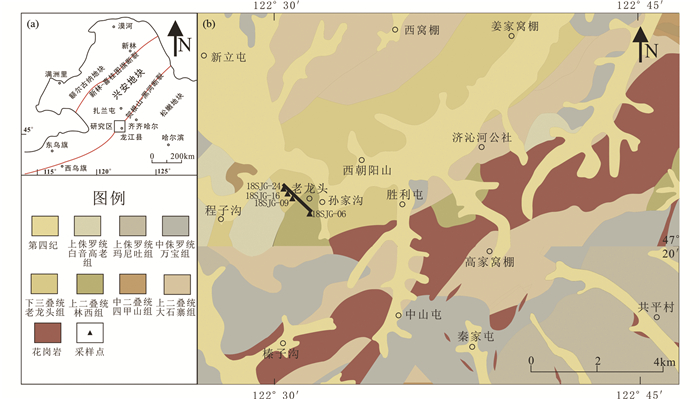
|
图 1 研究区地质构造简图(据黑龙江省革命委员会地质局区域地质测量队,1972①;黑龙江省地质区域地质测量第二队,1976②) Fig. 1 Simplified geological map of the study area |
① 黑龙江省革命委员会地质局区域地质测量队.1972.中华人民共和国地质图(1:20万扎赉特旗幅)
② 黑龙江省地质区域地质测量第二队.1976.中华人民共和国地质图(1:20万华安公社幅)
研究区出露地层包括二叠系、三叠系及侏罗系。其中二叠系出露较为局限,仅在研究区孙家沟及架子山出露乐平统林西组(图 1b),而下三叠统老龙头组则在研究区广泛出露。为了研究林西组及老龙头组地层的沉积、构造特征,故对龙江地区孙家沟村西山进行了剖面实测(图 2),其中林西组真实厚度>300m,老龙头组真实厚度>100m。林西组主要为一套灰黑色及灰绿色泥岩、粉砂岩、砂岩组成的碎屑沉积岩, 含丰富的淡水瓣鳃类和植物化石(图 3a, b),水平层理发育,指示当时的沉积环境为陆相还原环境。老龙头组以紫红色河、湖相沉积为特征,岩性主要为灰绿色砂岩、紫红色砂砾岩、砂岩及杂色砾岩,平行层理、板状交错层理、楔状交错层理、冲刷面等沉积构造发育(图 3c, d),指示当时沉积环境为陆相氧化环境。林西组与老龙头组地层岩性连续且递变,界面上下产状基本一致,故认为两套地层整合接触。
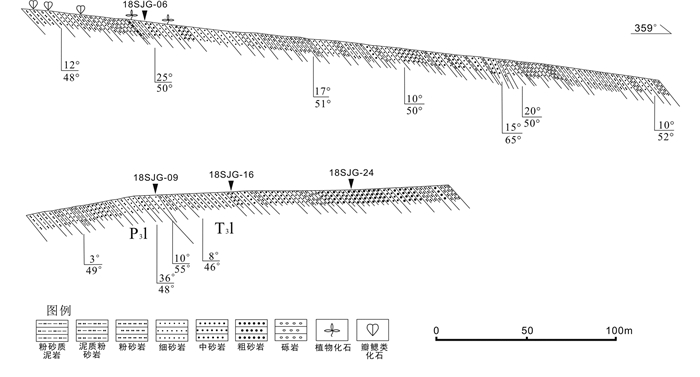
|
图 2 龙江地区孙家沟村乐平统林西组-下三叠统老龙头组实测剖面图 Fig. 2 Measured geological section of the Upper Permian Linxi Formation and the Lower Triassic Laolongtou Formation in Sunjiagoucun Village, Longjiang area |
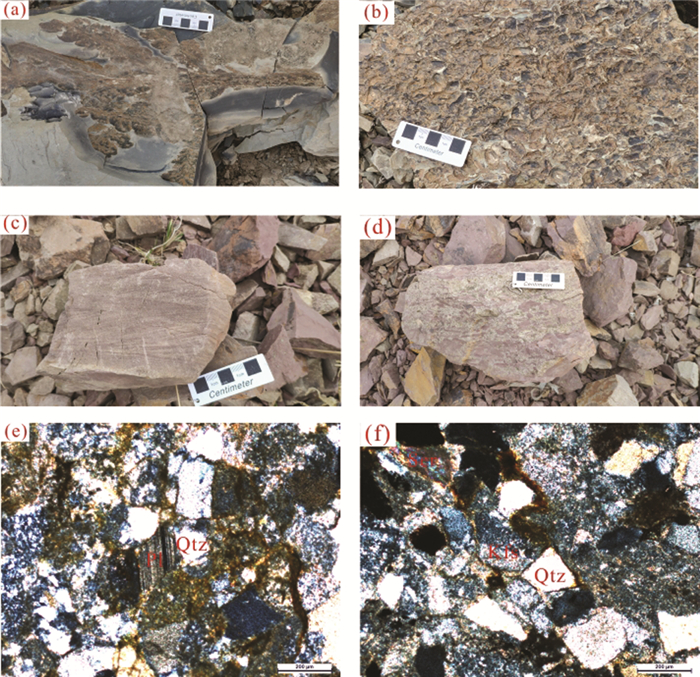
|
图 3 林西组及老龙头组砂岩野外和镜下照片 (a)林西组植物化石;(b)林西组瓣鳃类化石;(c)老龙头组砂岩中楔状交错层理;(d)老龙头组砂岩中冲刷构造;(e)林西组砂岩镜下照片(+);(f)老龙头组砂岩镜下照片(+). Qtz-石英;Pl-斜长石;Ffs-钾长石;Ser-绢云母 Fig. 3 Field and microscopic photographs of sandstone in Linxi and Laolongtou formations (a) plant fossils in Linxi Formation; (b) Lamelli branchia fossils in Linxi Formation; (c) wedge-shaped cross bedding in sandstone of Laolongtou Formation; (d) scour structure in sandstone of Laolongtou Formation; (e) microscopic photo of sandstone of Linxi Formation (+); (f) microscopic photo of sandstone of Laolongtou Formation(+). Qtz-quartz; Pl-plagioclase; Kfs-K-feldspar; Ser-sericite |
乐平世砂岩18SJG-06为中粒长石岩屑砂岩(图 3e),碎屑颗粒分选中等,磨圆较差,多为棱角状-次棱角状,颗粒支撑,接触式胶结,颗粒成分主要由石英、长石、岩屑及少量绿帘石及褐铁矿,石英含量35%~45%,主要为单晶石英。长石含量较少约5%~15%,为斜长石,具聚片双晶,未见钾长石。岩屑含量为20%~35%,且成分复杂,主要为火山岩岩屑,含少量沉积岩岩屑及变质岩岩屑。
三叠纪砂岩18SJG-09、18SJG-16和18SJG-24为中-粗粒长石岩屑砂岩(图 3f),碎屑颗粒分选较差,磨圆差,多为棱角状-次棱角状,颗粒支撑,接触式胶结,颗粒成分主要由石英、长石、岩屑及少量绿帘石及褐铁矿,以及少量长石蚀变后的绢云母。石英含量20%~35%,主要为单晶石英。长石含量较少约10%~20%,主要为斜长石,具聚片双晶,见少量具卡斯巴双晶的泥化钾长石。岩屑含量较高为30%~40%,成分复杂,主要为火山岩岩屑,含少量沉积岩岩屑及变质岩岩屑。云母类矿物含量 < 5%,多为绢云母。
2 分析方法重矿物分选由廊坊市科大岩石矿物分选技术服务有限公司完成,具体过程如下:(1)经无污染粉碎至10目(最大岩块粒径约2mm), 利用标准干筛筛选40~80目, 约0.45~0.18mm粒级(近乎大于砂岩分析样品的最小平均粒度), 以保证分离出的重矿物为碎屑成因颗粒; (2)通过重液、精淘分离和电磁分离出电磁、无磁和强磁三部分重矿物; (3)通过双目镜鉴定分离出不同的重矿物; (4)采用高精度天平完成计量, 最终通过重矿物密度(平均)值(Deer et al., 1992)将质量百分比换算为体积百分比。
锆石U-Pb定年分析在北京燕都中实测试技术有限公司进行,本次测试锆石微量元素含量和U-Pb同位素定年利用LA-ICP-MS同时分析完成。激光剥蚀系统为New Wave UP213,ICP-MS为德国耶拿M90。激光剥蚀过程中采用氦气作载气、氩气为补偿气以调节灵敏度,二者在进入ICP之前通过一个Y型接头混合。每个时间分辨分析数据包括大约20~30s的空白信号和50s的样品信号。对分析数据的离线处理(包括对样品和空白信号的选择、仪器灵敏度漂移校正、元素含量及U-Th-Pb同位素比值和年龄计算)采用软件ZSkits完成。
锆石微量元素含量利用SRM610作为多外标、Si作内标的方法进行定量计算(Liu et al., 2010)。这些NIST玻璃中元素含量的推荐值据GeoReM数据库(http://georem.mpch-mainz.gwdg.de/)。U-Pb同位素定年中采用锆石标准91500作外标进行同位素分馏校正,每分析5~10个样品点,分析2次91500,并对Plesovice分析一次作为监控,91500及Plesovice标样均符合推荐值(Wiedenbeck et al., 1995;Sláma et al., 2008)。锆石样品的U-Pb年龄谐和图绘制和年龄权重平均计算均采用Isoplot/Ex_ver3 (Ludwig, 2003)完成,普通铅校正使用Andersen (2002)方法完成。本次测试剥蚀直径根据实际情况选择30μm。
3 分析结果 3.1 重矿物组合砂岩的重矿物组成对于物源的变化有极其敏感的指示意义,不同类型的母岩经后期剥蚀搬运后沉积形成的碎屑岩往往拥有不同的重矿物组成特征。然而由于沉积物中重矿物特征受到母岩、风化搬运和沉积成岩等复杂地质条件的影响(Morton and Hallsworth, 1994),单一重矿物特征在物源分析过程中往往由于多因素的复杂影响, 而不能真实反映物源信息, 因此, 重矿物组合和单矿物原位分析等方法逐渐兴起, 并得到了广泛应用(Garzanti et al., 2012, 2013)。
本次选取林西组砂岩18SJG-06和老龙头组砂岩18SJG-09、18SJG-16和18SJG-24四件样品进行重矿物含量测试,识别出来的重矿物包括锆石、磷灰石、金红石、绿帘石、赤褐铁矿等(表 1)。主要重矿物为赤褐铁矿和锆石,磷灰石、金红石及绿帘石次之。黄铁矿多为沉积过程中自生形成,赤褐铁矿则由黄铁矿氧化形成,它们不具有源区岩石类型的指示意义,仅表明沉积环境为还原环境(张英利等,2018)。林西组砂岩样品18SJG-06重矿物组合为锆石+磷灰石+金红石+角闪石+绿帘石+重晶石,其中磷灰石+锆石+角闪石+金红石的组合指向原岩为中酸性岩浆岩,而少量的绿帘石和重晶石的存在指示原岩可能有少部分为变质岩及沉积岩。老龙头组砂岩重矿物组合与林西组砂岩相近似,这说明它们具有相近似的物源组成,但相较林西组砂岩重晶石含量明显减少,说明再旋回沉积岩对物源的贡献程度降低。
|
|
表 1 孙家沟林西组及老龙头组砂岩重矿物组成(%) Table 1 Heavy mineral composition (%) of Linxi and Laolongtou sandstone in Sunjiagou |
样品18SJG-06中碎屑锆石多为短柱状,长短轴比 < 2:1,CL图像中大部分锆石发育韵律环带(图 4a),Th/U比值为0.1~1.96,多数>0.4(表 2),呈现出典型的岩浆锆石的特征。本次共获得有效年龄48个(不协和度绝对值小于5%),碎屑锆石U-Pb年龄分布在278±3Ma~1966±15Ma之间,年龄峰值集中在284~310Ma及394~434Ma两个区间(图 5a, b)。
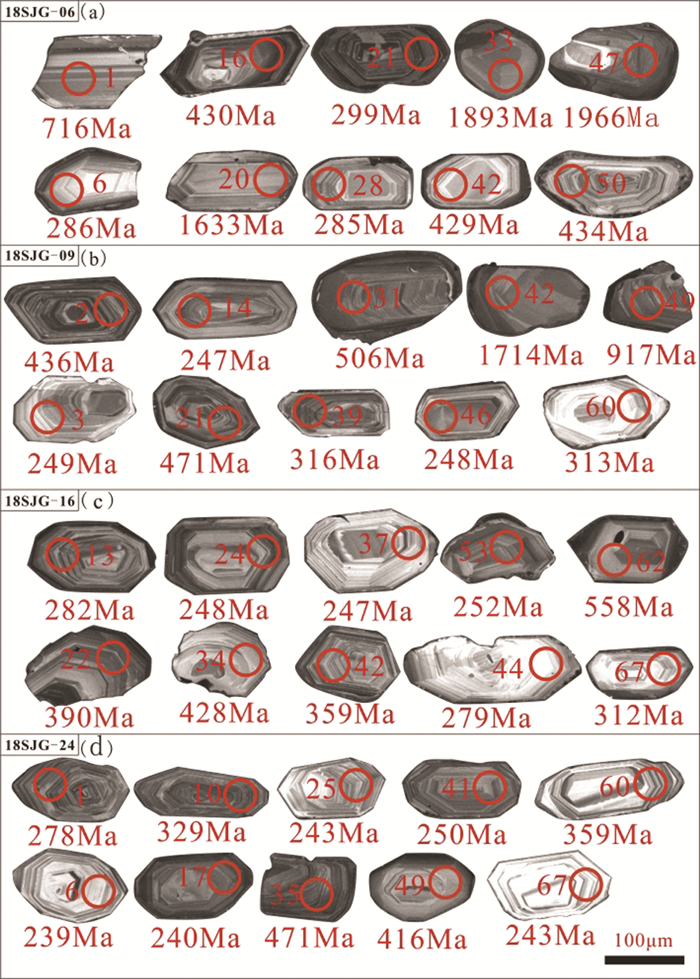
|
图 4 龙江地区林西组及老龙头组砂岩部分碎屑锆石CL图像及U-Pb年龄 Fig. 4 Representative CL images and U-Pb ages of sandstone detrital zircons from Linxi Formation and Laolongtou Formation in Longjiang area |
|
|
表 2 林西组及老龙头组砂岩样品碎屑锆石LA-ICP-MS U-Pb测试结果 Table 2 LA-ICP-MS U-Pb results for the detrital zircons from the Linxi Formation and Laolongtou Formation |
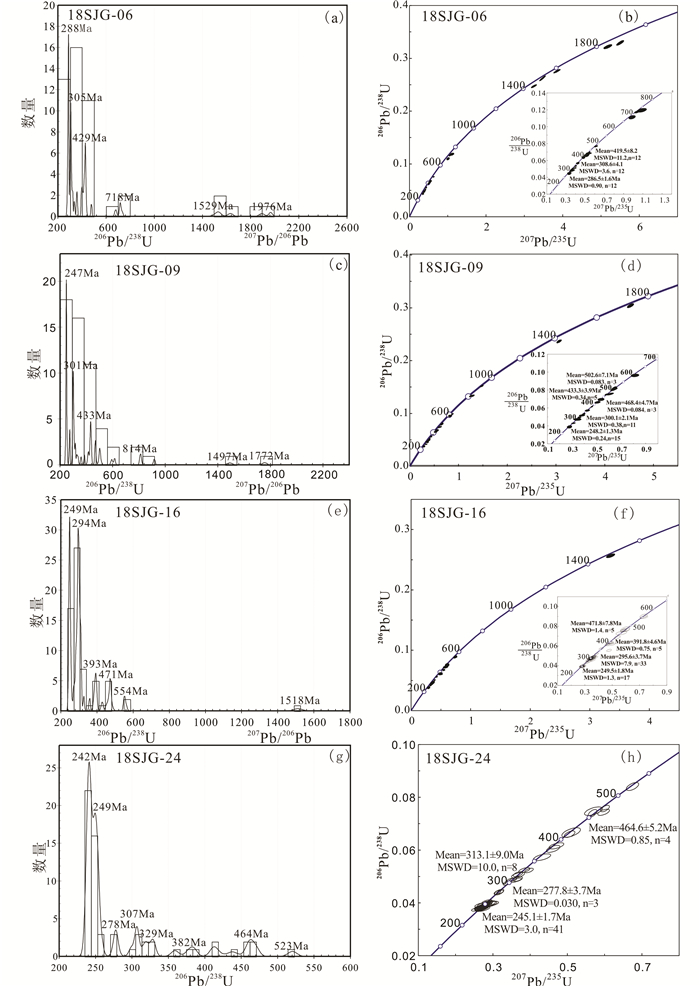
|
图 5 龙江地区林西组及老龙头组碎屑锆石U-Pb年龄谱图及协和曲线图 Fig. 5 U-Pb histograms and concordia diagrams of the detrital zircon U-Pb ages of the Linxi Formation and Laolongtou Formation in the Longjiang area |
样品18SJG-09中碎屑锆石多为短柱状,长短轴比 < 2.5:1,CL图像中大部分锆石发育韵律环带(图 4b),Th/U比值为0.26~0.98,多数>0.4(表 2),呈现出典型的岩浆锆石的特征。本次共获得有效年龄20个(不协和度绝对值小于5%),碎屑锆石U-Pb年龄分布在247±3Ma~812±7Ma之间,年龄峰值集中在247~303Ma及437~538Ma两个区间(图 5c, d)。
样品18SJG-16中碎屑锆石多为短柱状,长短轴比 < 3:1,CL图像中大部分锆石发育韵律环带(图 4c),Th/U比值为0.17~1.29,多数>0.4(表 2),呈现出典型的岩浆锆石的特征。本次共获得有效年龄65个(不协和度绝对值小于5%),碎屑锆石U-Pb年龄分布在243±4Ma~1512±23Ma之间,年龄峰值集中在243~312Ma及359~478Ma两区间(图 5e, f)。
样品18SJG-24中碎屑锆石多为短柱状,长短轴比 < 3:1,CL图像中大部分锆石发育韵律环带(图 4d),Th/U比值为0.15~1.19多数>0.4(表 2),呈现出典型的岩浆锆石的特征。本次共获得有效年龄67个(不协和度绝对值小于5%),碎屑锆石U-Pb年龄分布在237±3Ma~812±7Ma之间,年龄峰值集中在237~257Ma及277~329Ma两个区间(图 5g, h)。
4 讨论 4.1 地层时代碎屑锆石U-Pb年龄信息为碎屑岩的形成时代提供信息,可用来判断地层时代的下限。Dickinson and Gehrels (2009)通过研究科罗拉多高原中生代的锆石数据发现,约60%的样品中,最年轻的单个碎屑锆石晶粒年龄在沉积年龄的10Ma范围内。样品18SJG-06的最年轻碎屑锆石年龄为278±3Ma,表明该地层沉积时间应晚于乌拉尔世。地层中多处产出的大量淡水瓣鳃类、成层产出的植物化石及碎屑岩颜色为灰黑色和灰绿色表明该地层沉积于陆相还原环境, 植物化石包含美羊齿、副芦木、苏铁类等,为典型的安加拉植物群组分,指向地层沉积时代为乐平世(邓胜徽等,2009),且从锆石年龄对比图(图 6)中可以看出,老龙头组地层除最年轻的锆石年龄峰值外与林西组有着相近似的年龄峰值,说明两套地层物源具有继承性,结合前人研究,表明该套地层与上覆紫红色碎屑岩地层整合接触(刘兵等,2014),故认为该地层沉积于乐平世,为林西组地层,其沉积年龄可能为前人研究的254Ma(刘兵等,2014)。
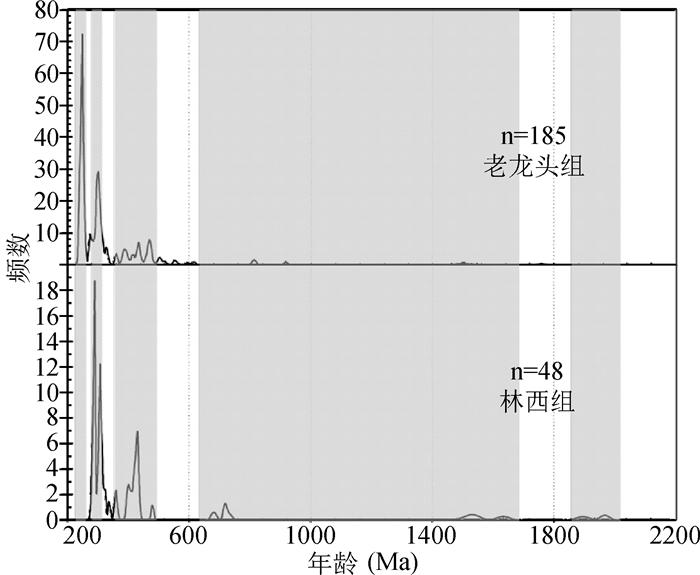
|
图 6 龙江地区林西组与老龙头组碎屑锆石U-Pb年龄对比图 Fig. 6 U-Pb age comparison of detrital zircons from Linxi Formation and Laolongtou Formation in Longjiang area |
老龙头组样品18SJG-09、18SJG-16和18SJG-24中,最年轻的锆石年龄分别是247±3Ma、243±4Ma及237±3Ma,这限定该套灰绿色及紫红色碎屑岩沉积于早三叠世到中三叠世,而非原来认定的早三叠世(刘兵等,2014)。
4.2 物源分析在四个砂岩样品的研究中,所测试的233颗碎屑锆石分别记录了五期构造热事件,分别为237~258Ma、270~329Ma、357~558Ma、680~1633Ma及1893~1966Ma,其中两个主要峰值年龄为247Ma和305Ma,次要峰值为358Ma、394Ma、429Ma、476Ma、558Ma、717Ma及1535Ma。
(1) 237~258Ma这组年龄仅出现于老龙头组样品中,共有73粒碎屑锆石,占老龙头组测试的碎屑锆石数量的39.5%。研究表明,在研究区南部分布有大量的酸性火山岩、花岗岩、闪长岩、基性火山岩、基性超基性侵入岩等(张晓晖等,2006;李锦轶等,2007;张连昌等,2008;叶栩松等,2011;王子进等,2013;徐久磊等,2013;刘希雯等,2015)。此外,近年来在测绘沙巴尔吐等六幅1:5万地质矿产图的过程中,发现了大量的三叠纪花岗质侵入岩(内蒙古自治区地质调查院, 2018①)。虽然部分学者认为这些火成岩形成于古亚洲洋闭合后的造山后阶段,但早-中三叠世铁镁质火成岩都具有较低的Ta含量(普遍低于3×10-6)和较高的Th/Ta比值(普遍大于3)的特点,长英质火成岩具有较高的Th/Ta(普遍大于10)比值的特点,且都富集大离子亲石元素,这些特点都是岛弧岩浆岩所特有的(Gorton and Schandl, 2000;Wood, 1980;Sun and McDonough, 1989)。该组锆石年龄可能与古亚洲洋洋壳消亡前的俯冲增生过程相关。
① 内蒙古自治区地质调查院.2018.中华人民共和国地质图(1:5万沙巴尔吐等六幅)
(2) 270~329Ma这组年龄共有86粒碎屑锆石,其中林西组样品中存在24颗,占总数的50%,老龙头组样品中存在62颗,占总数的33.5%。该峰值年龄与区域内报道的贺根山-黑河缝合带东南侧广泛发育的大石寨组弧火山岩(Zhang et al., 2008, 2017; Yu et al., 2017)及扎兰屯-嫩江一线的岛弧花岗岩(Wu et al., 2011;崔芳华等,2013)基本吻合。
(3) 357~558Ma这组年龄拥有多个峰值,分别为~358Ma、~394Ma、~429Ma、~476Ma及~552Ma,这几个峰值年龄又可以分为两组,其中357~493Ma的年龄与贺根山-黑河缝合带以西分布着的一套早古生代-晚古生代早期代表了古亚洲洋洋壳向北俯冲开始的岩浆弧(Feng et al., 2015, 2018; Ge et al., 2015; Shi et al., 2015; Wu et al., 2015)的年龄一致,而520~558Ma的峰值年龄对应于兴安地块泛非期变质基底,即扎兰屯变质杂岩的峰值年龄(周建波等,2014;那福超等,2018)。
(4) 碎屑锆石年龄中680~1633Ma的新元古代及中元古代年龄组分与大兴安岭北部广泛分布的前寒武变质基底兴华渡口群的夕线石榴片麻岩和斜长角闪岩的岩浆锆石峰值年龄(Miao et al., 2007; 周建波等,2011;表尚虎等,2012)及花岗质杂岩(Wu et al., 2012)、锡林浩特变质杂岩的碎屑锆石年龄(Chen et al., 2009)及花岗片麻岩的锆石年龄(孙立新等,2013a)、温都尔庙群中捕获锆石年龄(徐备等,2016)可作对比。
(5) 尽管目前在东北地区已经发现了许多的~1800Ma的古元古代结晶基底的锆石年龄(裴福萍等,2006;王颖等,2006;孙立新等,2013b),但绝大部分学者认为在内蒙古东部地区中二叠统-早三叠统碎屑岩中普遍存在的拥有~1800Ma及~2500Ma的峰值年龄的碎屑锆石直接或间接来自于华北克拉通(Shi et al., 2003;Han et al., 2012),这暗示古亚洲洋洋壳的向南俯冲开始于乐平世之前。
4.3 盆地性质前人对于内蒙古东部地区发育巨厚碎屑沉积的瓜德鲁普世-乐平世沉积盆地的性质进行了大量的研究,目前存在着两种意见:一种认为是统一大陆背景下形成的陆内裂谷盆地(徐备等,2014;耿元生等,2016;徐严等,2018),而另外一种认为板块持续会聚挤压背景下的残留洋盆或残余弧后盆地(李福来等,2016)
近几年,一种通过碎屑锆石年龄谱判断盆地构造类型的方法已经提出(Cawood et al., 2012),该方法把构造环境分为以下三种:会聚、碰撞以及伸展环境。会聚环境包括位于俯冲带环境中的盆地,从海沟延伸至弧后盆地。碰撞环境包括大陆碰撞期间和之后形成的盆地,如前陆盆地。伸展环境包括裂谷和裂谷后被动大陆边缘盆地以及内部盆地。不同样品(和环境)中锆石年龄的总体范围大致相似,但在最年轻的和与更老岩浆事件相关的锆石年龄比例方面,不同环境之间存在显著差异。会聚背景下的盆地的年龄接近沉积物年龄的碎屑锆石比例较高(一般大于50%),一些弧前盆地和海沟盆地具有单峰碎屑锆石谱,其年龄接近地层的沉积年龄,而弧后盆地则增加了来自相邻克拉通的旧碎屑的输入。大陆碰撞形成的盆地(例如前陆盆地)通常只含有少量的锆石,其年龄与沉积物的沉积年龄接近,含有相当比例的锆石年龄(50%至10%)在地层沉积时间的150Myr范围内。这一模式反映了同碰撞岩浆作用产生的锆石碎屑量的变化、海洋闭合有关的先前存在的岩浆弧以及反映造山带和克拉通前陆中捕获的单元的一系列较老的年龄。伸展盆地主要由比岩石年龄大得多的碎屑锆石年龄所控制,小于5%的锆石年龄在沉积年龄的150Myr以内。接近沉积年龄的锆石年龄可能反映了裂谷相关的岩浆活动,但由于其主要的镁铁质成分和由此产生的锆石产量较低,这只是年龄谱的一个次要组成部分。
从图 7中可以看出,以林西组沉积年龄254Ma、老龙头组沉积年龄237Ma来计算,前30%年轻的碎屑锆石年龄与地层沉积年龄之差都小于100Ma,说明碎屑锆石记录具有会聚背景盆地的特点,而非众多学者所认为的陆内裂谷盆地,而它们的结晶年龄-沉积年龄累计概率曲线从形态上更接近于弧前盆地,其年轻锆石的百分比含量相比于弧内和弧后盆地更高,却未达到海沟的程度。而通过对于碎屑锆石组成的研究,发现盆地的物源主要来自于盆地西部及南部与古亚洲洋双向俯冲相关的古生代弧火山岩,盆地位于岛弧远离大陆边缘(乌里雅斯太大陆边缘和华北克拉通大陆边缘)的一侧,结合砂岩的碎屑组成及碎屑重矿物组合特征,认为研究区乐平世-中三叠世沉积盆地类型为弧前盆地。
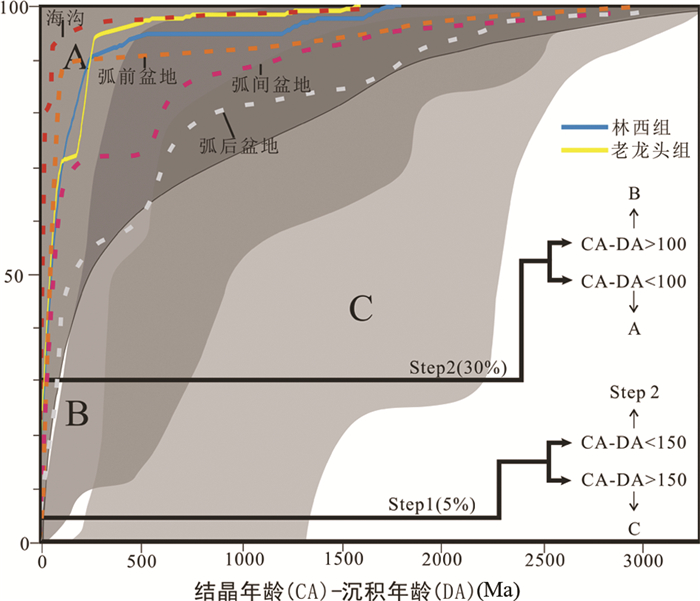
|
图 7 龙江地区林西组及老龙头组碎屑锆石年龄的构造分类图解(据Cawood et al., 2012) A-会聚背景; B-碰撞背景; C-拉伸背景 Fig. 7 Tectonic classification diagram of the detrital zircon U-Pb ages of the Linxi Formation and Laolongtou Formation in the Longjiang area (after Cawood et al., 2012) A-convergent setting; B-collisional setting; C-extensional setting |
(1) 林西组及老龙头组重矿物主要由锆石、磷灰石、金红石、绿帘石、角闪石、重晶石及赤褐铁矿组成,重矿物组合说明原岩主要为中酸性岩浆岩,并有少部分的变质岩及沉积岩。
(2) 研究区林西组砂岩最年轻的锆石年龄为278±3Ma,结合地层沉积特征,认为其沉积时代为乐平世。而老龙头组砂岩最年轻锆石年龄分别为247±3Ma、243±3Ma及237±3Ma,表明其沉积于早三叠世到中三叠世。
(3) 砂岩碎屑锆石LA-ICP-MS U-Pb年龄指示,林西组物源主要来自研究区西部270~329Ma大石寨组火山岩及其同期侵入岩和357~493Ma沿贺根山-黑河缝合带分布的早古生代-晚古生代早期岩浆弧,并有少量的前寒武变质基底及华北板块物源供给。老龙头组除了有和林西组年龄峰值组成相近似的物源组成之外,还有大量乐平世-中三叠世(237~258Ma)在研究区西部沿贺根山-黑河缝合带、南部地区沿温都尔庙-西拉木伦缝合带发育的与古亚洲洋洋壳俯冲相关的一系列弧岩浆岩。
(4) 结合对于研究区林西组及老龙头组砂岩碎屑组成、重矿物组合及盆地与火山弧位置关系的研究,我们认为研究区乐平世-中三叠世沉积盆地具有会聚背景,为弧前盆地。
致谢 本文碎屑锆石U-Pb测试工作在北京燕都中实测试技术有限公司完成,感谢张晗老师的帮助。两位审稿人老师及本刊编辑对文章提出了宝贵的修改意见,在此表示衷心的感谢。
Andersen T. 2002. Correction of common lead in U-Pb analyses that do not report 204Pb. Chemical Geology, 192(1-2): 59-79 DOI:10.1016/S0009-2541(02)00195-X |
Biao SH, Zheng WZ and Zhou XF. 2012. Zircon U-Pb age of the North Da Hinggan Mts., NE China and its constraint to attribute of the Ergun block. Acta Geologica Sinica, 86(8): 1262-1272 (in Chinese with English abstract) |
Cawood PA, Hawkesworth CJ and Dhuime B. 2012. Detrital zircon record and tectonic setting. Geology, 40(10): 875-878 DOI:10.1130/G32945.1 |
Chen B, Jahn BM and Tian W. 2009. Evolution of the Solonker suture zone: Constraints from zircon U-Pb ages, Hf isotopic ratios and whole-rock Nd-Sr isotope compositions of subduction- and collision-related magmas and forearc sediments. Journal of Asian Earth Sciences, 34(3): 245-257 DOI:10.1016/j.jseaes.2008.05.007 |
Cui FH, Zheng CQ, Xu XC, Yao WG, Shi L, Li J and Xu JL. 2013. Late Carboniferous magmatic activities in the Quanshenglinchang area, Great Xing'an Range: Constrains on the timing of amalgamation between Xing'an and Songnen massifs. Acta Geologica Sinica, 87(9): 1247-1263 (in Chinese with English abstract) |
Deer WA, Howie RA and Zussman J. 1992. An Introduction to the Rock-Forming Minerals (second edition). Hong Kong: Longman Scientific and Technical: 1-677
|
Deng SH, Wan CB and Yang JG. 2009. Discovery of a Late Permian Angara-Cathaysia mixed flora from Acheng of Heilongjiang, China, with discussions on the closure of the Paleoasian Ocean. Science in China (Series D), 52(11): 1746-1755 DOI:10.1007/s11430-009-0200-2 |
Dickinson WR. 1974. Plate tectonics and sedimentation. In: Dickinson WR (ed.). Tectonics and Sedimentation. Tulsa: SEPM Society for Sedimentary Geology, 1-27
|
Dickinson WR and Valloni R. 1980. Plate settings and provenance of sands in modern ocean basins. Geology, 8(2): 82-86 DOI:10.1130/0091-7613(1980)8<82:PSAPOS>2.0.CO;2 |
Dickinson WR and Gehrels GE. 2009. Use of U-Pb ages of detrital zircons to infer maximum depositional ages of strata: A test against a Colorado Plateau Mesozoic database. Earth and Planetary Science Letters, 288(1-2): 115-125 DOI:10.1016/j.epsl.2009.09.013 |
Eizenhöfer PR, Zhao GC, Sun M, Zhang J, Han YG and Hou WZ. 2015. Geochronological and Hf isotopic variability of detrital zircons in Paleozoic strata across the accretionary collision zone between the North China Craton and Mongolian arcs and tectonic implications. GSA Bulletin, 127(9-10): 1422-1436 DOI:10.1130/B31175.1 |
Feng ZQ, Jia J, Liu YJ, Wen QB, Li WM, Liu BQ, Xing DQ and Zhang L. 2015. Geochronology and geochemistry of the Carboniferous magmatism in the northern Great Xing'an Range, NE China: Constraints on the timing of amalgamation of Xing'an and Songnen blocks. Journal of Asian Earth Sciences, 113: 411-426 DOI:10.1016/j.jseaes.2014.12.017 |
Feng ZQ, Li WM, Liu YJ, Jin W, Wen QB, Liu BQ, Zhou JP, Zhang TA and Li XY. 2018. Early Carboniferous tectonic evolution of the Northern Heihe-Nenjiang-Hegenshan suture zone, NE China: Constraints from the mylonitized Nenjiang rhyolites and the Moguqi gabbros. Geological Journal, 53(3): 1005-1021 DOI:10.1002/gj.2940 |
Garzanti E, Resentini A, Vezzoli G, Andò S, Malusà M and Padoan M. 2012. Forward compositional modeling of Alpine orogenic sediments. Sedimentary Geology, 280: 149-164 DOI:10.1016/j.sedgeo.2012.03.012 |
Garzanti E, Vermeesch P, Andò S, Vezzoli G, Valagussa M, Allen K, Kadi KA and Al-Juboury AIA. 2013. Provenance and recycling of Arabian desert sand. Earth-Science Reviews, 120: 1-19 DOI:10.1016/j.earscirev.2013.01.005 |
Ge WC, Chen JS, Yang H, Zhao GC, Zhang YL and Tian DX. 2015. Tectonic implications of new zircon U-Pb ages for the Xinghuadukou Complex, Erguna Massif, northern Great Xing'an Range, NE China. Journal of Asian Earth Sciences, 106: 169-185 DOI:10.1016/j.jseaes.2015.03.011 |
Geng YS, Shen QH, Du LL and Song HX. 2016. Regional metamorphism and continental growth and assembly in China. Acta Petrologica Sinica, 32(9): 2579-2608 (in Chinese with English abstract) |
Gorton MP and Schandl ES. 2000. From continents to island arcs: A geochemical index of tectonic setting for arc-related and within-plate felsic to intermediate volcanic rocks. The Canadian Mineralogist, 38(5): 1065-1073 DOI:10.2113/gscanmin.38.5.1065 |
Han GQ, Liu YJ, Neubauer F, Jin W, Genser J, Ren SM, Li W, Wen QB, Zhao YL and Liang CY. 2012. LA-ICP-MS U-Pb dating and Hf isotopic compositions of detrital zircons from the Permian sandstones in Da Xing'an Mountains, NE China: New evidence for the eastern extension of the Erenhot-Hegenshan suture zone. Journal of Asian Earth Sciences, 49: 249-271 DOI:10.1016/j.jseaes.2011.11.011 |
Li FL, Xiao F, Meng FC and Ren ZY. 2016. Geochemical characteristics and implication for provenance of Upper Permian Linxi Formation clastic rocks in Solonker area, Inner Mongolia. Journal of Jilin University (Earth Science Edition), 46(6): 1769-1780 (in Chinese with English abstract) |
Li JL, Chen JL, Bai JK and Yan Z. 2013. Orogenic sedimentology series I: Sedimentions in the forearc of orogenic belts. Northwestern Geology, 46(1): 11-21 (in Chinese with English abstract) |
Li JY. 2006. Permian geodynamic setting of Northeast China and adjacent regions: Closure of the Paleo-Asian Ocean and subduction of the Paleo-Pacific Plate. Journal of Asian Earth Sciences, 26(3-4): 207-224 DOI:10.1016/j.jseaes.2005.09.001 |
Li JY, Gao LM, Sun GH, Li YP and Wang YB. 2007. Shuangjingzi Middle Triassic syn-collisional crust-derived granite in the east Inner Mongolia and its constraint on the timing of collision between Siberian and Sino-Korean paleo-plates. Acta Petrologica Sinica, 23(3): 565-582 (in Chinese with English abstract) |
Liu B, Wen QB, Liu YJ, Li WM, Feng ZQ, Zhou JP and Shen L. 2014. Contact relationship between the Upper Permian and Lower Triassic strata in the central Great Xing'an ranges and its tectonic implication: Constraints from the detrital zircon U-Pb ages. Geotectonica et Metallogenia, 38(2): 408-420 (in Chinese with English abstract) |
Liu XW, Yang H, Dong Y, Wang QH, Ge WC, Zhang YL and Tian DX. 2015. Zircon U-Pb ages and geochemical characteristics of the Triassic granites from the Mingshui area in the Da Hinggan Mountains and their tectonic implications. Acta Petrologica et Mineralogica, 34(2): 143-158 (in Chinese with English abstract) |
Liu YJ, Li WM, Feng ZQ, Wen QB, Neubauer F and Liang CY. 2017. A review of the Paleozoic tectonics in the eastern part of Central Asian Orogenic Belt. Gondwana Research, 43: 123-148 DOI:10.1016/j.gr.2016.03.013 |
Liu YS, Hu ZC, Zong KQ, Gao CG, Gao S, Xu J and Chen HH. 2010. Reappraisement and refinement of zircon U-Pb isotope and trace element analyses by LA-ICP-MS. Chinese Science Bulletin, 55(15): 1535-1546 DOI:10.1007/s11434-010-3052-4 |
Ludwig KR. 2003. User's Manual for Isoplot/Ex, Version 3.00: A Geochronological Toolkit for Microsoft Excel. Berkeley: Berkeley Geochronology Center Special Publication: 1-70
|
Miao LC, Liu DY, Zhang FQ, Fan WM, Shi YR and Xie HQ. 2007. Zircon SHRIMP U-Pb ages of the "Xinghuadukou Group" in Hanjiayuanzi and Xinlin areas and the "Zhalantun Group" in Inner Mongolia, Da Hinggan Mountains. Chinese Science Bulletin, 52(8): 1112-1124 DOI:10.1007/s11434-007-0131-2 |
Miao LC, Fan WM, Liu DY, Zhang FQ, Shi YR and Guo F. 2008. Geochronology and geochemistry of the Hegenshan ophiolitic complex: Implications for late-stage tectonic evolution of the Inner Mongolia-Daxinganling Orogenic Belt, China. Journal of Asian Earth Sciences, 32(5-6): 348-370 DOI:10.1016/j.jseaes.2007.11.005 |
Morton CA and Hallsworth. 1994. Identifying provenance: Specific features of detrital heavy mineral assemblages in sandstones. Sedimentary Geology, 90(3-4): 241-256 DOI:10.1016/0037-0738(94)90041-8 |
Na FC, Song WM, Liu YC, Wang Y, Fu JY, Sun W, Li LC, Wu JW, Ge JT and Tan HY. 2018. Chronological study and tectonic significance of Precambrian metamorphic rocks in Zhalantun area of Da Hinggan Mountains. Geological Bulletin of China, 37(9): 1607-1619 |
Pei FP, Xu WL, Yang DB, Zhao QG, Liu XM and Hu ZC. 2007. Zircon U-Pb geochronology of basement metamorphic rocks in the Songliao Basin. Chinese Science Bulletin, 52(7): 942-948 DOI:10.1007/s11434-007-0107-2 |
Şengör AMC, Natal'in BA and Burtman VS. 1993. Evolution of the Altaid tectonic collage and Palaeozoic crustal growth in Eurasia. Nature, 364(6435): 299-307 DOI:10.1038/364299a0 |
Shao JA, Wang Y and Tang KD. 2017. A reflection on the Xarmoron tectonomagmatic belt, Inner Mongolia, China. Acta Petrologica Sinica, 33(10): 3002-3010 (in Chinese with English abstract) |
Shi GH, Liu DY, Zhang FQ, Jian P, Miao LC, Shi YR and Tao H. 2003. SHRIMP U-Pb zircon geochronology and its implications on the Xilin Gol Complex, Inner Mongolia, China. Chinese Science Bulletin, 48(24): 2742-2748 DOI:10.1007/BF02901768 |
Shi L, Zheng CQ, Yao WG, Li J, Cui FH, Gao F, Gao Y, Xu JL and Han XM. 2015. Geochronological framework and tectonic setting of the granitic magmatism in the Chaihe-Moguqi region, central Great Xing'an Range, China. Journal of Asian Earth Sciences, 113: 443-453 DOI:10.1016/j.jseaes.2014.12.013 |
Sláma J, Košler J, Condon DJ, Crowley JL, Gerdes A, Hanchar JM, Horstwood MSA, Morris GA, Nasdala L, Norberg N, Schaltegger U, Schoene B, Tubrett MN and Whitehouse MJ. 2008. Plešovice zircon: A new natural reference material for U-Pb and Hf isotopic microanalysis. Chemical Geology, 249(1-2): 1-35 DOI:10.1016/j.chemgeo.2007.11.005 |
Sun LX, Ren BF, Zhao FQ, Gu YC, Li YF and Liu H. 2013a. Zircon U-Pb dating and Hf isotopic compositions of the Mesoporterozoic granitic gneiss in Xilinhot Block, Inner Mongolia. Geological Bulletin of China, 32(2-3): 327-340 (in Chinese with English abstract) |
Sun LX, Ren BF, Zhao FQ, Ji SP and Geng JZ. 2013b. Late Paleoproterozoic magmatic records in the Eerguna massif: Evidences from the zircon U-Pb dating of granitic gneisses. Geological Bulletin of China, 32(2-3): 341-352 (in Chinese with English abstract) |
Sun SS and McDonough WF. 1989. Chemical and isotopic systematics of oceanic basalts: Implications for mantle composition and processes. In: Saunders AD and Norry MJ (eds.). Magmatism in the Ocean Basins. Geological Society, London, Special Publication, 42(1): 313-345
|
Tong Y, Jahn BM, Wang T, Yang QD, Hong DW, Smith EI, Sun M, Gao JF, Yang QD and Huang W. 2015. Permian alkaline granites in the Erenhot-Hegenshan belt, northern Inner Mongolia, China: Model of generation, time of emplacement and regional tectonic significance. Journal of Asian Earth Sciences, 97: 320-336 DOI:10.1016/j.jseaes.2014.10.011 |
Wan YS, Li RW, Wilde SA, Liu DY, Chen ZY, Yan L, Song TR and Yin XY. 2005. UHP metamorphism and exhumation of the Dabie Orogen, China: Evidence from SHRIMP dating of zircon and monazite from a UHP granitic gneiss cobble from the Hefei Basin. Geochimica et Cosmochimica Acta, 69(17): 4333-4348 DOI:10.1016/j.gca.2005.03.055 |
Wang Y, Zhang FQ, Zhang DW, Miao LC, Li TS, Xie HQ, Meng QR and Liu DY. 2006. Zircon SHRIMP U-Pb dating of meta-diorite from the basement of the Songliao Basin and its geological significance. Chinese Science Bulletin, 51(15): 1877-1883 DOI:10.1007/s11434-006-2035-y |
Wang ZJ, Xu WL, Pei FP and Cao HH. 2013. Middle Permian-Early Triassic mafic magmatism and its tectonic implication in the eastern section of the southern margin of the Xing'an-Mongolian Orogenic Belt, NE China: Constraints from zircon U-Pb geochronology and geochemistry. Geological Bulletin of China, 32(2-3): 374-387 (in Chinese with English abstract) |
Wiedenbeck M, Allé P, Corfu F, Griffin WL, Meier M, Oberli F, von Quadt A, Roddick JC and Spiegel W. 1995. Three natural zircon standards for U-Th-Pb, Lu-Hf, trace element and REE analyses. Geostandards and Geoanalytical Research, 19(1): 1-23 DOI:10.1111/j.1751-908X.1995.tb00147.x |
Wood DA. 1980. The application of a Th-Hf-Ta diagram to problems of tectonomagmatic classification and to establishing the nature of crustal contamination of basaltic lavas of the British Tertiary Volcanic Province. Earth and Planetary Science Letters, 50(1): 11-30 DOI:10.1016/0012-821X(80)90116-8 |
Wu FY, Sun DY, Ge WC, Zhang YB, Grant ML, Wilde SA and Jahn BM. 2011. Geochronology of the Phanerozoic granitoids in northeastern China. Journal of Asian Earth Sciences, 41(1): 1-30 DOI:10.1016/j.jseaes.2010.11.014 |
Wu G, Chen YC, Chen YJ and Zeng QT. 2012. Zircon U-Pb ages of the metamorphic supracrustal rocks of the Xinghuadukou Group and granitic complexes in the Argun massif of the northern Great Hinggan Range, NE China, and their tectonic implications. Journal of Asian Earth Sciences, 49: 214-233 DOI:10.1016/j.jseaes.2011.11.023 |
Wu G, Chen YC, Sun FY, Liu J, Wang GR and Xu B. 2015. Geochronology, geochemistry, and Sr-Nd-Hf isotopes of the Early Paleozoic igneous rocks in the Duobaoshan area, NE China, and their geological significance. Journal of Asian Earth Sciences, 97: 229-250 DOI:10.1016/j.jseaes.2014.07.031 |
Xiao WJ, Windley BF, Hao J and Zhai MG. 2003. Accretion leading to collision and the Permian Solonker suture, Inner Mongolia, China: Termination of the central Asian orogenic belt. Tectonics, 22(6): 1069 DOI:10.1029/2002TC001484 |
Xiao WJ, Windley BF, Huang BC, Han CM, Yuan C, Chen HL, Sun M, Sun S and Li JY. 2009. End-Permian to Mid-Triassic termination of the accretionary processes of the southern Altaids: Implications for the geodynamic evolution, Phanerozoic continental growth, and metallogeny of Central Asia. International Journal of Earth Sciences, 98(6): 1189-1217 DOI:10.1007/s00531-008-0407-z |
Xu B, Charvet J, Chen Y, Zhao P and Shi GZ. 2013. Middle Paleozoic convergent orogenic belts in western Inner Mongolia (China): Framework, kinematics, geochronology and implications for tectonic evolution of the Central Asian Orogenic Belt. Gondwana Research, 23(4): 1342-1364 DOI:10.1016/j.gr.2012.05.015 |
Xu B, Zhao P, Bao QZ, Zhou YH, Wang YY and Luo ZW. 2014. Preliminary study on the pre-Mesozoic tectonic unit division of the Xing-Meng Orogenic Belt (XMOB). Acta Petrologica Sinica, 30(7): 1841-1857 (in Chinese with English abstract) |
Xu B, Xu Y, Li J and Li QS. 2016. Age of the Ondor Sum Group in western Inner Mongolia and its position in the Central Asia Orogenic Belt. Earth Science Frontiers, 23(6): 120-127 (in Chinese with English abstract) |
Xu JL, Zheng CQ, Shi L, Li J, Cui FH, Gao Y, Zhang XX and Gao F. 2013. Geochronology and geochemistry of the Yaergenchu I type granites in northern Da Hinggan range and its geodynamic implications. Acta Geologica Sinica, 87(9): 1311-1323 (in Chinese with English abstract) |
Xu Y, Yan LJ, Zhang JM, Li J and Yao ZW. 2018. Evidences of the Late Paleozoic extensional setting of the eastern Central Asian Orogenic Belt: Sedimentological and chronological studies of the Zhesi Formation in Shuangjing area, Inner Mongolia. Acta Petrologica Sinica, 34(10): 3051-3070 (in Chinese with English abstract) |
Yan Z, Wang ZQ, Wang T, Yan QR, Xiao WJ, Li JL, Han FL and Chen JL. 2007. Tectonic setting of Devonian sediments in the Qinling orogen: Constraints from detrital modes and geochemistry of clastic rocks. Acta Petrologica Sinica, 23(5): 1023-1042 (in Chinese with English abstract) |
Yan Z, Wang ZQ, Li JL, Yan QR, Wang T, Chen JL and Xu XY. 2008. Restoring the original tectonic types of sedimentary basins in the orogenic belts. Geological Bulletin of China, 27(12): 2001-2013 (in Chinese with English abstract) |
Ye XS, Liao QA and Ge MC. 2011. Petrogenesis and tectonic significance of Triassic peraluminous granitoids in Xilinhaote and Linxi area, Inner Mongolia. Geological Science and Technology Information, 30(3): 57-64 (in Chinese with English abstract) |
Yu Q, Ge WC, Zhang J, Zhao GC, Zhang YL and Yang H. 2017. Geochronology, petrogenesis and tectonic implication of Late Paleozoic volcanic rocks from the Dashizhai Formation in Inner Mongolia, NE China. Gondwana Research, 43: 164-177 DOI:10.1016/j.gr.2016.01.010 |
Zhang LC, Ying JF, Chen ZG, Wu HY, Wang F and Zhou XH. 2008. Age and tectonic setting of Triassic basic volcanic rocks in southern Da Hinggan Range. Acta Petrologica Sinica, 24(4): 911-920 (in Chinese with English abstract) |
Zhang XH, Zhang HF, Tang YJ and Liu JM. 2006. Early Triassic A-type felsic volcanism in the Xilinhaote-Xiwuqi, central Inner Mongolia: Age, geochemistry and tectonic implications. Acta Petrologica Sinica, 22(11): 2769-2780 (in Chinese with English abstract) |
Zhang XH, Zhang HF, Tang YJ, Wilde SA and Hu ZC. 2008. Geochemistry of Permian bimodal volcanic rocks from central Inner Mongolia, North China: Implication for tectonic setting and Phanerozoic continental growth in Central Asian Orogenic Belt. Chemical Geology, 249(3-4): 262-281 DOI:10.1016/j.chemgeo.2008.01.005 |
Zhang YL, Jia XT, Wang ZQ and Chen MY. 2018. New insights into provenance of Early Cambrian Xiannv Dong Formation in the Micangshan area: Evidence from sedimentology, heavy mineral and detrital zircon chronology. Acta Geologica Sinica, 92(9): 1918-1935 (in Chinese with English abstract) |
Zhang ZC, Chen Y, Li K, Li JF, Yang JF and Qian XY. 2017. Geochronology and geochemistry of Permian bimodal volcanic rocks from central Inner Mongolia, China: Implications for the Late Palaeozoic tectonic evolution of the south-eastern Central Asian Orogenic Belt. Journal of Asian Earth Sciences, 135: 370-389 DOI:10.1016/j.jseaes.2017.01.012 |
Zhao P, Xu B and Zhang CH. 2017. A rift system in southeastern Central Asian Orogenic Belt: Constraint from sedimentological, geochronological and geochemical investigations of the Late Carboniferous-Early Permian strata in northern Inner Mongolia (China). Gondwana Research, 47: 342-357 DOI:10.1016/j.gr.2016.06.013 |
Zhao YL, Li WM, Wen QB, Liang CY, Feng ZQ, Zhou JP and Shen L. 2016. Late Paleozoic tectonic framework of eastern Inner Mongolia: Evidence from the detrital zircon U-Pb ages of the Mid-Late Permian to Early Triassic sandstones. Acta Petrologica Sinica, 32(9): 2807-2822 (in Chinese with English abstract) |
Zhou JB, Wilde SA, Zhang XZ, Zhao GC, Zheng CQ, Wang YJ and Zhang XH. 2009. The onset of Pacific margin accretion in NE China: Evidence from the Heilongjiang high-pressure metamorphic belt. Tectonophysics, 478(3-4): 230-246 DOI:10.1016/j.tecto.2009.08.009 |
Zhou JB, Zhang XZ, Wilde SA and Zheng CQ. 2011. Confirming of the Heilongjiang ~500Ma Pan-African khondalite belt and its tectonic implications. Acta Petrologica Sinica, 27(4): 1235-1245 (in Chinese with English abstract) |
Zhou JB, Wang B, Zeng WS and Cao JL. 2014. Detrital zircon U-Pb dating of the Zhalantun metamorphic complex and its tectonic implications, Great Xing'an, NE China. Acta Petrologica Sinica, 30(7): 1879-1888 (in Chinese with English abstract) |
表尚虎, 郑卫政, 周兴福. 2012. 大兴安岭北部锆石U-Pb年龄对额尔古纳地块构造归属的制约. 地质学报, 86(8): 1262-1272. DOI:10.3969/j.issn.0001-5717.2012.08.009 |
崔芳华, 郑常青, 徐学纯, 姚文贵, 施璐, 李娟, 徐久磊. 2013. 大兴安岭全胜林场地区晚石炭世岩浆活动研究:对兴安地块与松嫩地块拼合时间的限定. 地质学报, 87(9): 1247-1263. |
邓胜徽, 万传彪, 杨建国. 2009. 黑龙江阿城晚二叠世安加拉-华夏混生植物群――兼述古亚洲洋的关闭问题. 中国科学(D辑), 39(12): 1744-1752. |
耿元生, 沈其韩, 杜利林, 宋会侠. 2016. 区域变质作用与中国大陆地壳的形成与演化. 岩石学报, 32(9): 2579-2608. |
李福来, 肖飞, 孟凡超, 任泽樱. 2016. 内蒙古索伦地区上二叠统林西组碎屑岩地球化学特征及其对物源的指示意义. 吉林大学学报(地球科学版), 46(6): 1769-1780. |
李继亮, 陈隽璐, 白建科, 闫臻. 2013. 造山带沉积学系列之一――弧造山带的弧前沉积. 西北地质, 46(1): 11-21. DOI:10.3969/j.issn.1009-6248.2013.01.002 |
李锦轶, 高立明, 孙桂华, 李亚萍, 王彦斌. 2007. 内蒙古东部双井子中三叠世同碰撞壳源花岗岩的确定及其对西伯利亚与中朝古板块碰撞时限的约束. 岩石学报, 23(3): 565-582. |
刘兵, 温泉波, 刘永江, 李伟民, 冯志强, 周建平, 申亮. 2014. 大兴安岭中段上二叠统-下三叠统接触关系研究――来自碎屑锆石年代学的证据. 大地构造与成矿学, 38(2): 408-420. |
刘希雯, 杨浩, 董玉, 王清海, 葛文春, 张彦龙, 田德欣. 2015. 大兴安岭明水地区三叠纪花岗岩的锆石U-Pb年龄、地球化学特征及构造意义. 岩石矿物学杂志, 34(2): 143-158. DOI:10.3969/j.issn.1000-6524.2015.02.002 |
那福超, 宋维民, 刘英才, 汪岩, 付俊彧, 孙巍, 李林川, 武将伟, 葛锦涛, 谭红艳. 2018. 大兴安岭扎兰屯地区前寒武纪变质岩系年龄及其构造意义. 地质通报, 37(9): 1607-1619. |
裴福萍, 许文良, 杨德彬, 赵全国, 柳小明, 胡兆初. 2006. 松辽盆地基底变质岩中锆石U-Pb年代学及其地质意义. 科学通报, 51(24): 2881-2887. DOI:10.3321/j.issn:0023-074X.2006.24.012 |
邵济安, 王友, 唐克东. 2017. 有关内蒙古西拉木伦带古生代-早中生代构造环境的讨论. 岩石学报, 33(10): 3002-3010. |
孙立新, 任邦方, 赵凤清, 谷永昌, 李艳峰, 刘卉. 2013a. 内蒙古锡林浩特地块中元古代花岗片麻岩的锆石U-Pb年龄和Hf同位素特征. 地质通报, 32(2-3): 327-340. |
孙立新, 任邦方, 赵凤清, 冀世平, 耿建珍. 2013b. 内蒙古额尔古纳地块古元古代末期的岩浆记录――来自花岗片麻岩的锆石U-Pb年龄证据. 地质通报, 32(2-3): 341-352. |
王颖, 张福勤, 张大伟, 苗来成, 李铁胜, 颉颃强, 孟庆任, 刘敦一. 2006. 松辽盆地南部变闪长岩SHRIMP锆石U-Pb年龄及其地质意义. 科学通报, 51(15): 1811-1816. DOI:10.3321/j.issn:0023-074X.2006.15.012 |
王子进, 许文良, 裴福萍, 曹花花. 2013. 兴蒙造山带南缘东段中二叠世末-早三叠世镁铁质岩浆作用及其构造意义――来自锆石U-Pb年龄与地球化学的证据. 地质通报, 32(2-3): 374-387. |
徐备, 赵盼, 鲍庆中, 周永恒, 王炎阳, 罗志文. 2014. 兴蒙造山带前中生代构造单元划分初探. 岩石学报, 30(7): 1841-1857. |
徐备, 徐严, 栗进, 李群生. 2016. 内蒙古西部温都尔庙群的时代及其在中亚造山带中的位置. 地学前缘, 23(6): 120-127. |
徐久磊, 郑常青, 施璐, 李娟, 崔芳华, 高源, 张行行, 高峰. 2013. 大兴安岭北段雅尔根楚Ⅰ型花岗岩年代学、岩石地球化学及其地球动力学意义. 地质学报, 87(9): 1311-1323. |
徐严, 颜林杰, 张佳明, 栗进, 姚仲伟. 2018. 中亚造山带东段晚古生代伸展构造环境的证据:内蒙古双井地区哲斯组沉积学及年代学研究. 岩石学报, 34(10): 3051-3070. |
闫臻, 王宗起, 王涛, 闫全人, 肖文交, 李继亮, 韩芳林, 陈隽璐. 2007. 秦岭造山带泥盆系形成构造环境:来自碎屑岩组成和地球化学方面的约束. 岩石学报, 23(5): 1023-1042. |
闫臻, 王宗起, 李继亮, 闫全人, 王涛, 陈隽璐, 徐学义. 2008. 造山带沉积盆地构造原型恢复. 地质通报, 27(12): 2001-2013. DOI:10.3969/j.issn.1671-2552.2008.12.005 |
叶栩松, 廖群安, 葛梦春. 2011. 内蒙古锡林浩特、林西地区三叠纪过铝质花岗岩的成因及构造意义. 地质科技情报, 30(3): 57-64. DOI:10.3969/j.issn.1000-7849.2011.03.007 |
张连昌, 英基丰, 陈志广, 吴华英, 王非, 周新华. 2008. 大兴安岭南段三叠纪基性火山岩时代与构造环境. 岩石学报, 24(4): 911-920. |
张晓晖, 张宏福, 汤艳杰, 刘建明. 2006. 内蒙古中部锡林浩特-西乌旗早三叠世A型酸性火山岩的地球化学特征及其地质意义. 岩石学报, 22(11): 2769-2780. |
张英利, 贾晓彤, 王宗起, 陈木银. 2018. 米仓山地区早寒武世仙女洞组沉积物源新认识:沉积学、重矿物和碎屑锆石年代学的证据. 地质学报, 92(9): 1918-1935. DOI:10.3969/j.issn.0001-5717.2018.09.011 |
赵英利, 李伟民, 温泉波, 梁琛岳, 冯志强, 周建平, 申亮. 2016. 内蒙东部晚古生代构造格局:来自中、晚二叠-早三叠世砂岩碎屑锆石U-Pb年代学的证据. 岩石学报, 32(9): 2807-2822. |
周建波, 张兴洲, Wilde SA, 郑常青. 2011. 中国东北~500Ma泛非期孔兹岩带的确定及其意义. 岩石学报, 27(4): 1235-1245. |
周建波, 王斌, 曾维顺, 曹嘉麟. 2014. 大兴安岭地区扎兰屯变质杂岩的碎屑锆石U-Pb年龄及其大地构造意义. 岩石学报, 30(7): 1879-1888. |
 2019, Vol. 35
2019, Vol. 35








